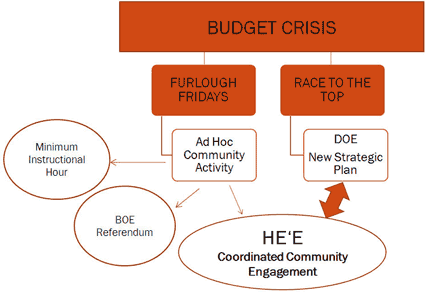 The Back-Drop
The Back-Drop
Since 2009 there has been a major shift in public sentiment in support of public education in Hawaii. From the Furlough Friday crisis to Hawaii’s successful Race to the Top application, the national spotlight has shone on our public schools and our community has been moved to action.
The public has demanded that our elected leaders prioritize education. Education became a major electoral issue in last year’s gubernatorial campaign and is a stated priority of the Abercrombie administration. For its part, the state legislature also responded to public pressure by passing an impressive docket of bills in the 2010 session ranging from mandating minimum instructional hours; to placing on the ballot a constitutional referendum to change an elected Board of Education to an appointed one. There was also a transformational body of legislation passed in support of Hawaii’s Race to the Top application. In addition, at the end of the 2010 session the Legislature appropriated $67 million from the state’s special funds to eliminate furlough days for the 2010-11 school year.
At the national level, public education has consistently been a major priority of the Obama administration. Recognizing the vulnerability of state public school systems during the economic downturn, the US Department of Education allocated unprecedented amounts of stimulus money to stave off drastic cuts. In addition to this need-based funding, Hawaii was also awarded $75 million in the highly competitive Race to the Top competition, placing third overall in the national competition for its aggressive reform strategy. Despite the much needed funding and an impressive reform strategy, systemic transformation will not succeed without engaging the many stakeholders that support public education.
Meeting a Need
In May 2010, The Learning Coalition, Hawaii Education Matters, and the University Of Hawaii College Of Education organized an ‘Ohana Engagement Forum’ to focus on how key stakeholders involved with pre-school through to post secondary education (P-20) might work together with schools, families and communities to support one another more effectively. The Forum participants overwhelmingly supported the formation of a state-wide education coalition to coordinate member efforts and leverage existing resources in support of transformational change within Hawaii’s public school system.
Formation of HE‘E
Over 30 organizations, including members of community organizations, parent groups, Hawaii Department of Education leaders, organized labor and policy makers, have participated between June and December 2010 in the strategic planning of the coalition. Meetings have been open to any organization that desired to participate and all decisions have been made by consensus. The Learning Coalition has been and continues to be committed to allocating resources to support the development and ongoing maintenance of HE‘E by providing professional staff and technical assistance.
HE‘E also identified a platform of specific policies and initiatives that will receive coalition backing. The coalition works with policy makers to support its platform.
HE‘E Mission Statement
The HE‘E Coalition promotes a child-centered and strength-based public education system in which families, communities and schools are valued and empowered to help every student succeed. HE‘E works to bring diverse stakeholders together to harness collective energy, share resources, and identify opportunities for progressive action in education.
HE‘E Launch
HE‘E officially launched on January 31, 2011, with a gathering at the State Capitol. Over 60 guests including Governor Abercrombie, Superintendent Matayoshi, Senator Tokuda, Representative Takumi, legislators, media, members and supporters attended. Governor Abercrombie’s spoke at the launch and the Star Advertiser covered the event in an article titled “Education Coalition unites reform backers.” Click to view the HE‘E launch presentation (133 K PDF).